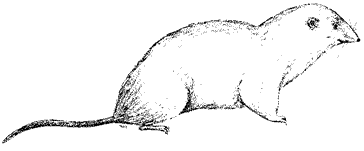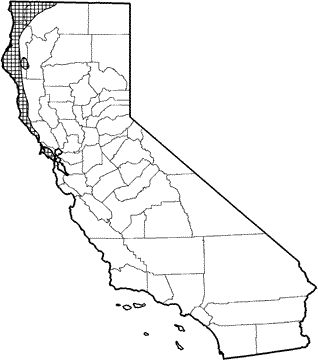
Fog Shrew
Distribution, Abundance, and Seasonality
The Fog shrew is common along the Pacific Coast from Del Norte and Siskiyou cos. south to San Francisco Bay. It prefers damp, marshy or brushy microhabitats in coastal Douglas-fir and redwood forests and associated wet meadow and fresh emergent wetland habitats. It also occurs in montane riparian and hardwood-conifer habitats.

Range Map
Specific Habitat Requirements
Feeding: Major foods include slugs and snails, centipedes, amphibians, insect larvae, and other invertebrates. Some seeds and fungi also eaten (Whitaker and Maser 1976). Captive animals cache food and immobilize animal prey (Maser and Hooven 1974). This species forages by searching under ground cover or in litter and decaying logs.
Cover: Uses heavy ground cover and decaying logs. Digs burrows, especially if other cover is absent.
Reproduction: Builds nests of grass, leaves, and moss in captivity (Maser and Hooven 1974).
Water: Drinks water in captivity (Maser and Hooven 1974).
Pattern: Tends to occur in moist microhabitats such as marshy spots, moist streambanks, wet brushy areas (e.g., thickets of alder and skunk cabbage), and decaying logs in understories of forests.
Species Life History
Activity Patterns: The Fog shrew is noctunal (Maser and Hooven 1974, Whitaker and Maser 1976). It wakes to eat cached food. Probably active yearlong.
Seasonal Movements / Migration: No data found.
Home Range: No data found.
Territory: No data found.
Reproduction: Reproductively active Feb-Aug.; 2-6 young/litter (Carraway 1985).
Niche: The Fog shrew occurs with S. trowbridgii, which prefers the litter layer of mature forests, and S. vagrans, which is most common in meadows and grassy areas where the two species occur together.
Sources & References
California Department of Fish and Game, 1999.
California's Wildlife, Sacramento, CA.
Written by: J. Harris, reviewed by: H. Shellhammer, edited by: S. Granholm
Carraway, L. N. 1985. Sorex pacificus. Mammal. Species No. 231. 5pp. Hennings, D., and R. S. Hoffmann. 1977. A review of the taxonomy of the Sorex vagrans species complex from western North America. Univ. Kans. Publ., Mus. Nat. Hist. 68:1-35. Ingles, L. G. 1965. Mammals of the Pacific states. Stanford Univ. Press, Stanford, CA. 506pp. Larrison, E. J. 1976. Mammals of the northwest. Seattle Audubon Soc., Wash. 256pp.
Maser, C., and E. F. Hooven. 1974. Notes on the behavior and food habits of captive Pacific shrews, Sorex pacificus pacificus. Northwest Sci. 48:81-95.
Whitaker, J. O., Jr., and C. Maser. 1976. Food habits of five western Oregon shrews. Northwest Sci. 50:102-107.
California Animal Facts | California's Wildlife